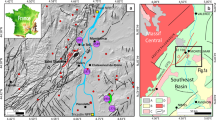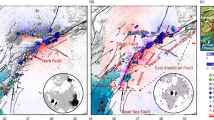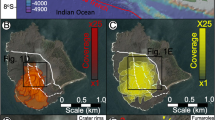Abstract
A magnitude 7.5 earthquake hit the city of Palu in Sulawesi, Indonesia on 28 September 2018 at 10:02:43 (coordinated universal time). It was followed a few minutes later by a 4–7-m-high tsunami. Palu is situated in a narrow pull-apart basin surrounded by high mountains of up to 2,000 m altitude. This morphology has been created by a releasing bend in the Palu-Koro fault, a rapidly moving left-lateral strike-slip fault. Here we present observations derived from optical and radar satellite imagery that constrain the ground surface displacements associated with the earthquake in great detail. Mapping of the main rupture and associated secondary structures shows that the slip initiated on a structurally complex and previously unknown fault to the north, extended southwards over 180 km and passed through two major releasing bends. The 30 km section of the rupture south of Palu city is extremely linear, and slightly offset from the mapped geological fault at the surface. This part of the rupture accommodates a large and smooth surface slip of 4–7 m, with no shallow slip deficit. Almost no aftershock seismicity was recorded from this section of the fault. As these characteristics are similar to those from known supershear segments, we conclude that the Palu earthquake probably ruptured this segment at supershear velocities.
This is a preview of subscription content, access via your institution
Access options
Access Nature and 54 other Nature Portfolio journals
Get Nature+, our best-value online-access subscription
$29.99 / 30 days
cancel any time
Subscribe to this journal
Receive 12 print issues and online access
$259.00 per year
only $21.58 per issue
Buy this article
- Purchase on Springer Link
- Instant access to full article PDF
Prices may be subject to local taxes which are calculated during checkout




Similar content being viewed by others
Code availability
Synthetic aperture radar data were processed using GMTSAR software, freely available from https://topex.ucsd.edu/gmtsar/. Optical satellite images were mosaicked using the Geospatial Data Abstraction Library (http://gdal.org) and then correlated using the COSI-Corr software package available at www.tectonics.caltech.edu/slip_history/spot_coseis/download_software.html. Deformation generated by a static earthquake source was modelled using Okada57 equations implemented in the disloc program (www.physics.hmc.edu/GL/disloc/disloc.c).
Data availability
The data sets generated during the current study (displacement fields from Landsat-8, Sentinel-2 and WorldView image correlation and from the ALOS-2 interferogram, as well as the static slip distribution) are available from the corresponding author upon request. Raw satellite optical imagery was made freely available by ESA (Sentinel-2, https://scihub.copernicus.eu/dhus/#/home), USGS (Landsat-8, https://earthexplorer.usgs.gov/) and DigitalGlobe (WorldView, www.digitalglobe.com/opendata/indonesia-earthquake-tsunami/). Raw ALOS-2 data availability is restricted to PI investigation at www.eorc.jaxa.jp/ALOS/en/aw3d30/data/index.htm.
Change history
05 March 2019
An amendment to this paper has been published and can be accessed via a link at the top of the paper.
References
Cipta, A. et al. in Geohazards in Indonesia: Earth Science for Disaster Risk Reduction (eds Cummins, P. R. & Meilano, I.) 133–152 (Geological Society Special Publications Vol. 441, Geological Society, London, 2017).
Prasetya, G. S., de Lange, W. P. & Healy, T. R.The Makassar Strait tsunamigenic region, Indonesia. Nat. Hazards 24, 295–307 (2001).
Puntodewo, S. S. O. et al. GPS measurements of crustal deformation within the Pacific–Australia Plate boundary zone in Irian Jaya, Indonesia. Tectonophysics 237, 141–153 (1994).
Rangin, C. et al. Plate convergence measured by GPS across the Sundaland/Philippine Sea Plate deformed boundary; the Philippines and eastern Indonesia. Geophys. J. Int. 139, 296–316 (1999).
Hall, R. Cenozoic geological and plate tectonic evolution of SE Asia and the SW Pacific: computer-based reconstructions, model and animations. J. Asian Earth Sci. 20, 353–431 (2002).
Wallace, L. M., McCaffrey, R., Beavan, J. & Ellis, S. Rapid microplate rotations and backarc rifting at the transition between collision and subduction. Geology 33, 857–860 (2005).
Socquet, A. et al. Microblock rotations and fault coupling in SE Asia triple junction (Sulawesi, Indonesia) from GPS and earthquake slip vector data. J. Geophys. Res. 111, B08409 (2006).
Bellier, O. et al. High slip rate for a low seismicity along the Palu-Koro active fault in central Sulawesi (Indonesia). Terra Nova 13, 463–470 (2001).
Watkinson, I. M. & Hall, R. in Geohazards in Indonesia: Earth Science for Disaster Risk Reduction (eds Cummins, P. R. & Meilano, I.) 71–120 (Geological Society Special Publications, Vol. 441, Geological Society, London, 2017).
Vigny, C. et al. Migration of seismicity and earthquake interactions monitored by GPS in SE Asia triple junction: Sulawesi, Indonesia. J. Geophys. Res. 107, 2231 (2002).
Simons, W. et al. A decade of GPS in Southeast Asia: resolving Sundaland motion and boundaries. J. Geophys. Res. 112, B06420 (2007).
Walpersdorf, A., Vigny, C., Manurung, P., Subarya, C. & Sutisna, S. Determining the Sula Block kinematics in the triple junction area in Indonesia by GPS. Geophys. J. Int. 135, 351–361 (1998).
Silver, E. A., McCaffrey, R. & Smith, R. B. Collision, rotation, and the initiation of subduction in the evolution of Sulawesi, Indonesia. J. Geophys. Res. Solid Earth 88, 9407–9418 (1983).
Bellier O. et al. in GEODYSSEA Final Report GFZ Scientific Technical Report 98/14 (eds Wilson, P. & Michel, G. W.) 276–312 (GeoForshingsZentrum, 1988).
Walpersdorf, A., Vigny, C., Subarya, C. & Manurung, P. Monitoring of the Palu-Koro Fault (Sulawesi) by GPS. Geophys. Res. Lett. 25, 2313–2316 (1998).
Stevens, C. et al. Rapid rotations about a vertical axis in a collisional setting revealed by the Palu Fault, Sulawesi, Indonesia. Geophys. Res. Lett. 26, 2677–2680 (1999).
M w 7.5 Palu earthquake, Indonesia. US Geological Survey https://earthquake.usgs.gov/earthquakes/eventpage/us1000h3p4/executive#executive (2018).
M w 7.5 earthquake, Sulawesi 2018/09/28 10:02:43 UTC. Geoscope Observatory http://geoscope.ipgp.fr/index.php/en/catalog/earthquake-description?seis=us1000h3p4 (2018).
Bao, H. et al. Early and persistent supershear rupture of the 2018 magnitude 7.5 Palu earthquake. Nat. Geosci. https://doi.org/10.1038/s41561-018-0297-z (2019).
Bouchon, M. & Karabulut, H. The aftershock signature of supershear earthquakes. Science 320, 1323–1325 (2008).
Leprince, S., Barbot, S., Ayoub, F. & Avouac, J. Automatic and precise orthorectification, coregistration, and subpixel correlation of satellite images, application to ground deformation measurements. IEEE Trans. Geosci. Remote Sens. 45, 1529–1558 (2007).
Emre, Ö., Awata, Y., & Duman, T. Y. (eds) Surface Rupture Associated with the 17 August 1999 Izmit Earthquake (General Directorate of Mineral Research and Exploration, Ankara, 2003).
Barka, A. et al. The surface rupture and slip distribution of the 17 August 1999 Izmit earthquake (M 7.4), North Anatolian fault. Bull. Seismol. Soc. Am. 92, 43–60 (2002).
Michel, R. & Avouac, J. P. Deformation due to the 17 August 1999 Izmit, Turkey, earthquake measured from SPOT images. J. Geophys. Res. Solid Earth 107, 2062 (2002).
Klinger, Y. et al. High-resolution satellite imagery mapping of the surface rupture and slip distribution of the M w 7.8, 14 November 2001 Kokoxili earthquake, Kunlun fault, northern Tibet, China. Bull. Seismol. Soc. Am. 95, 1970–1987 (2005).
King, G., Klinger, Y., Bowman, D. & Tapponnier, P. Slip-partitioned surface breaks for the M w 7.8 2001 Kokoxili earthquake, China. Bull. Seismol. Soc. Am. 95, 731–738 (2005).
Bouchon, M. et al. Faulting characteristics of supershear earthquakes. Tectonophysics 493, 244–253 (2010).
Robinson, D. P., Das, S. & Searle, M. P. Earthquake fault superhighways. Tectonophysics 493, 236–243 (2010).
Andrews, D. J. & Ben-Zion, Y. Wrinkle-like slip pulse on a fault between different materials. J. Geophys. Res. 102, 553–571 (1997).
Milliner, C. W. et al. Quantifying near-field and off-fault deformation patterns of the 1992 M w 7.3 Landers earthquake. Geochem. Geophys. Geosyst. 16, 1577–1598 (2015).
Boore, D. M. A note on the effect of simple topography on seismic SH waves. Bull. Seismol. Soc. Am. 62, 275–284 (1972).
Ma, S. A physical model for widespread near-surface and fault zone damage induced by earthquakes. Geochem. Geophys. Geosyst. 9, Q11009 (2008).
Xu, X. et al. Refining the shallow slip deficit. Geophys. J. Int. 204, 1867–1886 (2016).
Fialko, Y. Probing the mechanical properties of seismically active crust with space geodesy: study of the coseismic deformation due to the 1992 M w 7.3 Landers (southern California) earthquake. J. Geophys. Res. 109, B03307 (2004).
Gombert, B. et al. Revisiting the 1992 Landers earthquake: a Bayesian exploration of co-seismic slip and off-fault damage. Geophys. J. Int. 212, 839–852 (2018).
Klinger, Y. Relation between continental strike-slip earthquake segmentation and thickness of the crust. J. Geophys. Res. 115, B07306 (2010).
Fialko, Y., Sandwell, D., Simons, M. & Rosen, P. Three-dimensional deformation caused by the Bam, Iran, earthquake and the origin of shallow slip deficit. Nature 435, 295–299 (2005).
Stirling, M. W., Wesnousky, S. G. & Shimazaki, K. Fault trace complexity, cumulative slip, and the shape of the magnitude-frequency distribution for strike-slip faults: a global survey. Geophys. J. Int. 124, 833–868 (1996).
Brodsky, E., Gilchrist, J., Sagy, A. & Collettini, C. Faults smooth gradually as a function of slip. Earth Planet. Sci. Lett. 302, 185–193 (2011).
Dolan, J. F. & Haravitch, B. D. How well do surface slip measurements track slip at depth in large strike-slip earthquakes? The importance of fault structural maturity in controlling on-fault slip versus off-fault surface deformation. Earth Planet. Sci. Lett. 388, 38–47 (2014).
Hooper, A. et al. Importance of horizontal seafloor motion on tsunami height for the 2011 M w = 9.0 Tohoku-Oki earthquake. Earth Planet. Sci. Lett. 361, 469–479 (2013).
Carvajal, M. et al. The extraordinary tsunami of Palu 2018 and its implications for Chile. In XV Congreso Geologico Chileno (2018).
Schäfer, A. M. & Wenzel, F. Tsupy: computational robustness in tsunami hazard modelling. Comp. Geosci. 102, 148–157 (2017).
Bouchon, M. & Vallée, M. Observation of long supershear rupture during the magnitude 8.1 Kunlunshan earthquake. Science 301, 824–826 (2003).
Dunham, E. M. & Archuleta, R. J. Evidence for a supershear transient during the 2002 Denali fault earthquake. Bull. Seismol. Soc. Am. 94, S256–S268 (2004).
Konca, A. O., Leprince, S., Avouac, J. P. & Helmberger, D. V. Rupture process of the 1999 M w 7.1 Duzce earthquake from joint analysis of SPOT, GPS, InSAR, strong-motion, and teleseismic data: a supershear rupture with variable rupture velocity. Bull. Seismol. Soc. Am. 100, 267–288 (2010).
Lassere, C. et al. Coseismic deformation of the 2001 M w = 7.8 Kokoxili earthquake in Tibet, measured by synthetic aperture radar interferometry. J. Geophys. Res. Solid Earth 110, B12408 (2005).
Ozacar, A. A. & Beck, S. L. The 2002 Denali fault and 2001 Kunlun fault earthquakes: complex rupture processes of two large strike-slip events. Bull. Seismol. Soc. Am. 94, S278–S292 (2004).
King, G. & Nábělek, J. Role of fault bends in the initiation and termination of earthquake rupture. Science 228, 984–987 (1985).
Sandwell, D., Mellors, R., Tong, X., Wei, M. & Wessel, P. Open radar interferometry software for mapping surface deformation. Eos Trans. AGU 92, 28 (2011).
Sandwell, D., Mellors, R., Tong, X., Wei, M., & Wessel, P. GMTSAR: An InSAR Processing System Based on Generic Mapping Tools Scripps Institution of Oceanography Technical Report (2011).
Tadono, T. et al. Precise global DEM generation by ALOS PRISM.ISPRS Ann. Photogram Remote Sensing Spatial Inf. Sci. II-4, 71–76 (2014).
Chen, C. W. & Zebker, H. A. Phase unwrapping for large SAR interferograms: statistical segmentation and generalized network models. IEEE Trans. Geosci. Remote Sensing 40, 1709–1719 (2002).
GDAL/OGR contributors. GDAL/OGR Geospatial Data Abstraction (Open Source Geospatial Foundation).
Ayoub, F., Leprince, L. & Avouac, J.-P. User’s Guide to COSI-CORR: Co-registration of Optically Sensed Images and Correlation (California Institute of Technology, 2015).
Beyer, R. A., Alexandrov, O. & McMichael, S. The Ames Stereo Pipeline: NASA’s open source software for deriving and processing terrain data. Earth Space Sci. 5, 537–548 (2018).
Okada, Y. Surface deformation due to shear and tensile faults in a half-space. Bull. Seismol. Soc. Am. 75, 1135–1154 (1985).
Grandin, R. et al. The September 2005 Wal’is-Dabbahu rifting event, Afar (Ethiopia): constraints provided by geodetic data. J. Geophys. Res. 114, B08404 (2009).
Tiranda, H. T ectonostratigraphic Evolution of Offshore NW Sulawesi with Implications for the Hydrocarbon Prospectivity. MSc thesis, Univ. London (2017).
Loveless, J. P. & Meade, B. J. Spatial correlation of interseismic coupling and coseismic rupture extent of the 2011 Mw= 9.0 Tohoku Oki earthquake. Geophys. Res. Lett. 38, L17306 (2011).
Jonsson, S., Zebker, H., Segall, P. & Amelung, F. Fault slip distribution of the 1999 M w 7.1 Hector Mine, California, earthquake, estimated from satellite radar and GPS measurements. Bull. Seismol. Soc. Am. 92, 1377–1389 (2002).
Acknowledgements
Our first thoughts go to the population of Sulawesi and to the victims of this earthquake. Satellite optical imagery has been made freely available by ESA (Sentinel-2, https://scihub.copernicus.eu/dhus/#/home), USGS (Landsat-8, https://earthexplorer.usgs.gov/) and DigitalGlobe (WorldView, www.digitalglobe.com/opendata/indonesia-earthquake-tsunami/). We thank JAXA for providing ALOS-2 data under PI investigation no. 3328 (ALOS 6th RA) and the AW3D30 digital elevation model. We also thank the contributors to GMT and GMTSAR opensource software.
Author information
Authors and Affiliations
Contributions
J.H. processed and analysed the image correlation data. E.P. processed and analysed ALOS-2 interferograms. A.S. coordinated the study, analysed the displacement maps and inverted for coseismic slip distributions. M.B. cross-examined the observations and results. All the authors discussed the content of the paper and shared the writing.
Corresponding author
Ethics declarations
Competing interests
The authors declare no competing interests.
Additional information
Publisher’s note: Springer Nature remains neutral with regard to jurisdictional claims in published maps and institutional affiliations.
Supplementary information
Supplementary Figures
Supplementary Figures
Rights and permissions
About this article
Cite this article
Socquet, A., Hollingsworth, J., Pathier, E. et al. Evidence of supershear during the 2018 magnitude 7.5 Palu earthquake from space geodesy. Nat. Geosci. 12, 192–199 (2019). https://doi.org/10.1038/s41561-018-0296-0
Received:
Accepted:
Published:
Issue Date:
DOI: https://doi.org/10.1038/s41561-018-0296-0
This article is cited by
-
Laboratory earthquakes decipher control and stability of rupture speeds
Nature Communications (2023)
-
The role of pore fluids in supershear earthquake ruptures
Scientific Reports (2023)
-
Dueling dynamics of low-angle normal fault rupture with splay faulting and off-fault damage
Nature Communications (2023)
-
Distribution and characteristics of shallow landslides triggered by the 2018 Mw 7.5 Palu earthquake, Indonesia
Landslides (2023)
-
Estimating tidal inundation in the aftermath of the 2018 Palu earthquake
Environmental Earth Sciences (2023)



